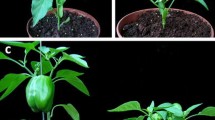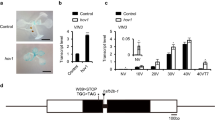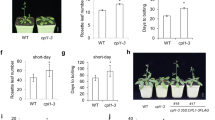Abstract
Key message
CaVIL1 is a homolog of VIL1, a regulator of vernalization response in Arabidopsis and acts as a flowering promoter in pepper which does not respond to vernalization and photoperiod.
Abstract
As part of our goal to study the genetic and molecular basis of transition to flowering in pepper, we isolated the late-flowering mutant E-2698. Aside from late flowering, multiple pleiotropic alterations of the shoot structure, such as enlarged and distorted leaves, weak apical dominance, and reduced angle of the lateral branches were observed, indicating a broad role for the mutated gene in pepper development. Genetic mapping and sequence analyses revealed that the disrupted gene in E-2698 is the pepper homolog of VERNALIZATION INSENSITIVE 3-LIKE 1 (VIL1) that acts as a regulator of vernalization in Arabidopsis through chromatin modification. The pepper gene, CaVIL1, contains a plant homeodomain motif associated with chromatin modification and a VERNALIZATION INSENSITIVE 3-interacting domain that is truncated in E-2698 and in two other allelic mutants. Because pepper flowering does not respond to vernalization, we postulate that CaVIL1 regulates flowering time via chromatin modification of unknown targets. Expression analysis indicated that CaVIL1 activates the flowering promoter CaFLOWERING LOCUS T and represses the flowering repressor CaAPETALA2. Furthermore, CaVIL1 represses several genes from the FLOWERING LOCUS C (FLC)-LIKE clade that are clustered together in the pepper genome. This indicates their possible involvement in flowering regulation in this species. Our results show that CaVIL1 is a major regulator of flowering and interacts with other flowering promoters and repressors, as well as with FLC-LIKE genes whose function in flowering regulation is not yet known in pepper.







Similar content being viewed by others
References
Alvarez J, Guli CL, Yu XH, Smyth DR (1992) TERMINAL FLOWER: a gene affecting inflorescence development in Arabidopsis thaliana. Plant J 2:103–116
An Y, Guo Y, Liu C, An H (2015) BdVIL4 regulates flowering time and branching through repressing miR156 in ambient temperature dependent way in Brachypodium distachyon. Plant Physiol Biochem 89:92–99
Borovsky Y, Sharma VK, Verbakel H, Paran I (2015) CaAP2 transcription factor is a candidate gene for a flowering repressor and a candidate for controlling natural variation of flowering time in Capsicum annuum. Theor Appl Genet 128:1073–1082
Cohen O, Borovsky Y, David-Schwartz R, Paran I (2012) CaJOINTLESS is a MADS-box gene involved in suppression of vegetative growth in all shoot meristems in pepper. J Exp Bot 63:4947–4957
Cohen O, Borovsky Y, David-Schwartz R, Paran I (2014) Capsicum annuum S (CaS) promotes reproductive transition and is required for flower formation in pepper (Capsicum annuum. New Phytol 202:1014–1023
Elitzur T, Nahum H, Borovsky Y, Pekker I, Eshed Y, Paran I (2009) Co-ordinated regulation of flowering time, plant architecture and growth by FASCICULATE: the pepper orthologue of SELF PRUNING. J Exp Bot 60:869–880
Fu D, Dunbar M, Dubcovsky J (2007) Wheat VIN3-like PHD finger genes are up-regulated by vernalization. Mol Genet Genom 277:301–313
Jeifetz D, David-Schwartz R, Borovsky Y, Paran I (2011) CaBLIND regulates axillary meristem initiation and transition to flowering in pepper. Planta 234:1227–1236
Kim DH, Sung S (2013) Coordination of the vernalization response through a VIN3 and FLC gene family regulatory network in Arabidopsis. Plant Cell 25:454–469
Li C, Wang Y, Xu L, Nie S, Chen Y, Liang D, Sun X, Karanja BK, Luo X, Liu L (2016) Genome-wide characterization of the MADS-Box gene family in Radish (Raphanus sativus L) and assessment of its roles in flowering and floral organogenesis. Front Plant Sci. https://doi.org/10.3389/fpls201601390
Lippman Z, Cohen O, Alvarez J, Abu-Abied M, Pekker I, Paran I (2008) The making of a compound inflorescence in tomato and related Nightshades. PLoS Biol. https://doi.org/10.1371/journalpbio0060288
Mason MG, Ross JJ, Babst BA, Wienclaw BN, Beveridge CA (2014) Sugar demand, not auxin, is the initial regulator of apical dominance. Proc Natl Acad Sci USA 111:6092–6097
Michelmore RW, Paran I, Kesseli RV (1991) Identification of markers linked to disease-resistance genes by bulked segregant analysis: a rapid method to detect markers in specific genomic regions by using segregating populations. Proc Natl Acad Sci USA 88:9828–9832
Mouriz A, López-González L, Jarillo JA, Piñeiro M (2015) PHDs govern plant development. Plant Signal Behav. https://doi.org/10.4161/155923242014993253
Muller D, Schmitz G, Theres K (2006) Blind homologous R2R3 Myb genes control the pattern of lateral meristem initiation in Arabidopsis. Plant Cell 18:586–597
Paran I, Borovsky Y, Nahon S, Cohen O (2007) The use of induced mutations to study shoot architecture in Capsicum. Isr J Plant Sci 55:125–131
Parenicova L, de Folter S, Kieffer M et al (2003) Molecular and phylogenetic analyses of the complete MADS-Box transcription factor family in Arabidopsis: new openings to the MADS world. Plant Cell 15:1538–1551
Qin C, Yu C, Shen Y, Fang X, Chen L, Min J et al (2014) Whole-genome sequencing of cultivated and wild peppers provides insights into Capsicum domestication and speciation. Proc Natl Acad Sci USA 111:5135–5140
Ratcliffe OJ, Nadzan GC, Reuber TL, Riechmann JL (2001) Regulation of flowering in Arabidopsis by an FLC homologue. Plant Physiol 126:122–132
Ratcliffe OJ, Kumimoto RW, Wong BJ, Riechmann JL (2003) Analysis of the Arabidopsis MADS AFFECTING FLOWERING gene family: MAF2 prevents vernalization by short periods of cold. Plant Cell 15:1159–1169
Rodríguez GR, Moyseenko JB, Robbins MD, Huarachi Morejón N, Francis DM, van der Knaap E (2010) Tomato analyzer: a useful software application to collect accurate and detailed morphological and colorimetric data from two-dimensional objects. J Vis Exp. https://doi.org/10.3791/1856
Roychoudhry S, Del Bianco M, Kieffer M, Kepinski S (2013) Auxin controls gravitropic setpoint angle in higher plant lateral branches. Curr Biol 23:1497–1504
Scortecci KC, Michaels SD, Amasino RM (2001) Identification of a MADS-box gene, FLOWERING LOCUS M, that represses flowering. Plant J 26:229–236
Sung S, Amasino R (2004) Vernalization in Arabidopsis thaliana is mediated by the PHD finger protein VIN3. Nature 427:159–164
Sung S, Schmitz RJ, Amasino RM (2006) A PHD finger protein involved in both the vernalization and photoperiod pathways in Arabidopsis. Genes Dev 20:3244–3248
Sung S, Schmitz RJ, Amasino R (2007) The role of VIN3-LIKE genes in environmentally induced epigenetic regulation of flowering. Plant Signal Behav 2:127–128
Tamura K, Stecher G, Peterson D, Filipski A, Kumar S (2013) MEGA6: molecular evolutionary genetics analysis version 60. Mol Biol Evol 30:2725–2729
Tutar Y (2012) Pseudogenes. Comp Funct Genom. https://doi.org/10.1155/2012/424526
Wang J, Hu J, Qian Q, Xue H-W (2013) LC2 and OsVIL2 promote rice flowering by photoperoid-induced epigenetic silencing of OsLF. Mol Plant 6:514–527
Whittaker C, Dean C (2017) The FLC locus: a platform for discoveries in epigenetics and adaptation. Annu Rev Cell Dev Biol 33:555–575
Xiao J, Sekhwal MK, Li P, Ragupathy R, Cloutier S, Wang X, You FM (2016) Pseudogenes and their genome-wide prediction in plants. Int J Mol Sci. https://doi.org/10.3390/ijms17121991
Yang J, Lee S, Hang R, Kim SR, Lee YS, Cao X et al (2013) OsVIL2 functions with PRC2 to induce flowering by repressing OsLFL1 in rice. Plant J 73:566–578. https://doi.org/10.1111/tpj12057
Zhao SQ, Hu J, Guo LB, Qian Q, Xue HW (2010) Rice leaf inclination2 a VIN3-like protein regulates leaf angle through modulating cell division of the collar. Cell Res 20:935–947
Funding
This research was supported by The Israel Science Foundation (Grant No. 1349/10).
Author information
Authors and Affiliations
Corresponding author
Ethics declarations
Conflict of interest
The authors declare that they have no conflict of interest.
Additional information
Communicated by Sanwen Huang.
Electronic supplementary material
Below is the link to the electronic supplementary material.
Rights and permissions
About this article
Cite this article
Mohan, V., Borovsky, Y., Kamara, I. et al. CaVIL1, a plant homeodomain gene that promotes flowering in pepper. Theor Appl Genet 131, 2639–2649 (2018). https://doi.org/10.1007/s00122-018-3179-2
Received:
Accepted:
Published:
Issue Date:
DOI: https://doi.org/10.1007/s00122-018-3179-2




